An effective SEO content strategy can mean the difference between being ahead of the curve and struggling to keep up with the competition. Are you ready to enhance your online presence? Do you want to reach more users on search engines than before? If yes, then this article is designed to help you succeed by unlocking the secrets of a robust SEO content strategy. From understanding its significance for businesses to exploring specific components and actionable steps, we will guide you through every aspect of this crucial topic.
What is an SEO Content Strategy?

An SEO (Search Engine Optimization) content strategy revolves around creating, organizing, and optimizing content to achieve better visibility in search engine results pages (SERPs). This approach targets specific keywords and delivers relevant, high-quality material that addresses user intent and search engine guidelines. An effective SEO content strategy generates significant organic traffic by combining thoughtful planning with attention to technical detail. It establishes your credibility as a valuable source of information. Ultimately, it will lead to higher rankings on Google and other search engines, improved brand recognition, and sustainable growth for your online presence.
Why is SEO Content Strategy Important for Your Business?
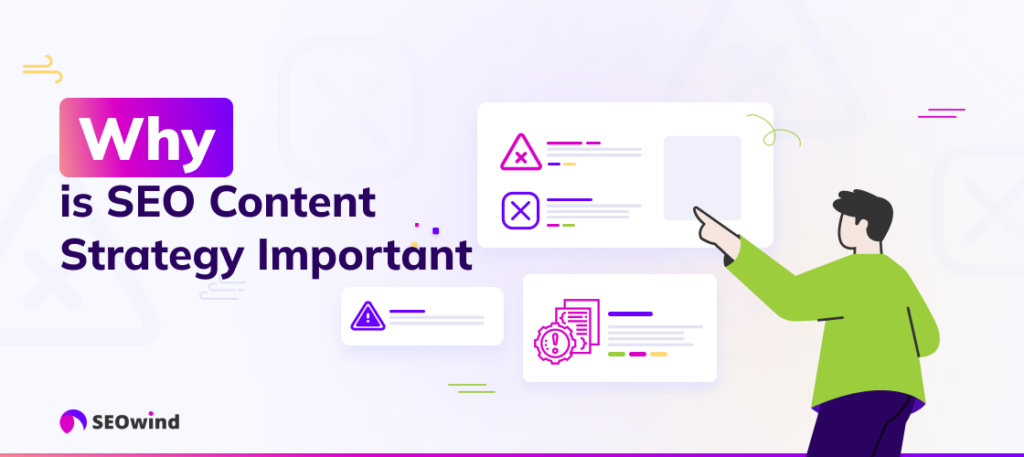
SEO content strategy is the key to unlocking your website’s potential and driving organic traffic, eventually leading to higher conversion rates and increased revenue. Implementing a well-thought-out SEO content plan benefits your business in various ways:
- Improves online visibility: By optimizing your content for search engines, you make it easier for them to find and rank your pages. This enhanced visibility translates into a greater reach among potential customers searching for products or services similar to yours.
- Establishes authority: Creating high-quality, informative content showcases your expertise within your industry. As readers find value in what you offer, they’re more likely to share it with others – expanding brand awareness and helping establish credibility.
- Enhances user experience: When you prioritize SEO in your content strategy, you focus on providing helpful information that meets users’ needs and expectations. A well-structured site with easy-to-understand content ensures better navigation and a positive user experience.
- Cost-effective marketing: Once optimized webpages start ranking on search engine results pages (SERPs), organic traffic flows without additional costs, such as paid ads or sponsored posts. Compared to traditional advertising methods, SEO is a cost-effective long-term investment for businesses of all sizes.
- Conversion optimization: An effective SEO content strategy also involves catering to reader preferences by including compelling visuals, clear call-to-action (CTA) prompts, and engaging writing styles that resonate with target audiences. Such optimization increases the likelihood of visitors converting into customers or clients while browsing your website’s offerings.
In short, integrating an SEO content strategy into your digital marketing efforts allows you to maximize online exposure and build trust among website visitors. It improves their on-site experience and increases conversion rates, contributing to sustainable business growth.
What are the Components of an SEO Strategy?
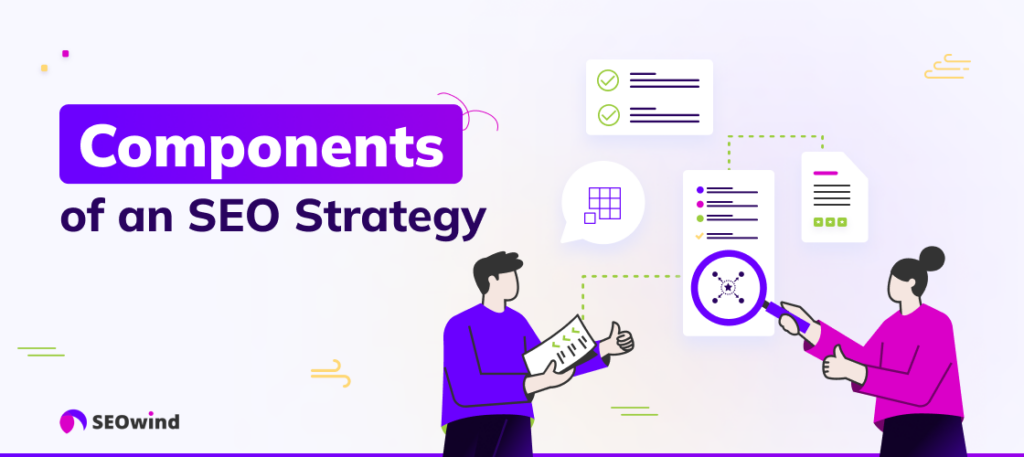
A successful SEO content strategy includes various components that enhance a website’s visibility and attract organic traffic. By understanding these aspects, businesses can leverage them to maximize their reach. Look at three key components: ranking, high-quality content, and measurements.
Rankings
Rankings play a critical role in your overall SEO.content.strategy. Higher search engine rankings increase visibility, allowing potential customers to discover your brand quickly. To improve your rankings:
- Conduct comprehensive keyword research.
- Optimize on-page elements such as meta tags, headings, and page titles.
- Focus on building high-quality backlinks that strengthen your site’s authority.
- Ensure quick loading times by optimizing images and reducing file sizes.
- Improve mobile-friendliness as it directly impacts user experience and rankings.
High-Quality Content
High-quality content lies at the heart of any effective SEO.content.strategy:
- Develop well-researched articles that provide valuable information to readers.
- Create engaging multimedia content like videos, infographics, or interactive quizzes.
- Use clear language and structured texts for easy readability.
- Maintain up-to-date factual information sourced from reliable authorities.
- Employ persuasive techniques like storytelling or social proof to engage readers emotionally.
Producing great content increases dwell time (how long a user spends on your site), reduces bounce rates (users leaving after only one page), helps build user trust, and makes it more likely they convert into customers.
Measurements
Measuring the performance of your SEO strategy is crucial for continuous growth and improvement:
- Use analytics tools like Google Analytics or Adobe Analytics to track essential website traffic and conversion metrics.
- Monitor keyword rankings regularly with specialized tools such as Ahrefs or SEMrush; this helps you understand which keywords bring the most value and target similar phrases.
- Assess your content’s engagement by analyzing social shares, likes, and comments – these are excellent indicators of audience interest.
- Track the performance of backlinks using tools like Majestic or Moz to learn which links contribute the most towards your site’s authority.
By understanding the components of an SEO strategy and monitoring its success, businesses can continually refine and improve their tactics for maximum growth opportunities.
What are the Four Pillars of SEO?

A successful SEO content strategy supports its foundation with four key pillars. These essential components improve your website’s visibility, increase organic traffic, and drive conversions while enhancing user experience.
Technical SEO
The first pillar, Technical SEO, focuses primarily on optimizing your website’s infrastructure. It involves ensuring proper functionality, performance, security, and accessibility for search engines and users alike. Some essential aspects of technical SEO include:
- Crawlability: Ensuring search engine bots can efficiently access and navigate your site.
- Indexing: Facilitating proper indexing so that relevant pages appear in search results.
- Site speed: Optimization measures such as image compression or browser caching enhance load times.
- Mobile-friendliness: Offering a seamless experience across various devices to cater to increasingly mobile users.
- HTTPS: Implementing secure connections (SSL certificates) for improved safety.
Content
The second pillar is content – the lifeblood of any successful SEO content strategy. Quality content attracts readers’ interest and search engines’ attention by effectively providing value and addressing user intent. Key considerations in developing quality content include:
- Originality: Producing unique material that sets you apart from competitors.
- Relevance: Covering topics related to your niche or industry that matter to your target audience.
- Readability: Presenting information comprehensibly with clear headings, proper formatting, and concise sentences for easy consumption.
- Keywords usage: Identifying high-importance terms using appropriate keyword research tools and weaving them organically throughout the text.
On-Page SEO
On-Page SEO is the third pillar which deals with further refining individual web pages for optimal search engine rankings. Working hand-in-hand with quality content production, this element includes technical optimization measures designed to enhance the overall page experience. Critical on-page optimization practices include:
- Title tags: Creating optimized, concise, and descriptive HTML title tags that feature your primary keyword.
- Meta descriptions: Crafting accurate summaries of your content, capturing user intent with targeted keywords.
- Header tags (H1-H6): Employ a clear hierarchy of headings for better readability and SEO performance.
- Internal linking: Building comprehensive linking structures that improve navigation and evenly distribute authority across pages.
Off-Page SEO
The final pillar, Off-Page SEO, deals with activities outside your website but significantly influences its ranking potential. This includes building trust and authority through links from other websites, social media engagement, or online reviews. Crucial off-page factors to consider in an SEO content marketing strategy are:
- Backlinks: Acquiring high-quality inbound links from relevant websites by creating valuable content worth referencing or conducting successful outreach campaigns.
- Social signals: Increase website visibility by encouraging shares and interactions on platforms like Facebook, Twitter, or LinkedIn.
- Brand reputation: Addressing consumer feedback positively and maintaining consistency across various channels to build community trust.
By combining these four pillars – Technical SEO, Content, On-Page SEO, and Off-Page SEO – you can create a robust and effective SEO content strategy that maximizes your reach while firmly establishing yourself as an industry expert.
What are the 5 Most Important Parts of SEO?
A comprehensive SEO content strategy should be built around five essential components. By understanding and addressing these elements, you can optimize your content to achieve higher rankings on search engines and maximize visibility.
Audience
One crucial aspect of any effective SEO content strategy is knowing who you’re writing for—your target audience. To create valuable content that resonates with readers, identify your ideal customer’s demographics, interests, and pain points. Build buyer personas to gain deeper insights into their characteristics and preferences. Crafting content tailored to your audience’s needs will improve engagement and establish trust and credibility.
Industry
Conducting thorough industry research is vital for identifying popular trends, challenges faced by competitors, and the latest best practices within your niche. By staying informed about ongoing developments within your sector, you can produce relevant content tackling prevailing issues or providing innovative solutions. Additionally, understanding the competitive landscape enables you to position your offerings strategically against others in the market.
User Intent
User intent is pivotal when developing a successful SEO content marketing strategy. It refers to what a searcher intends to achieve when typing a query into search engines like Google. There are usually three main types of user intent:
- Informational: The searcher seeks information on a specific topic.
- Navigational: The searcher wants to find pages related to a particular website or brand.
- Transactional: The searcher needs a product or service and aims to make a purchase.
To cater effectively to user intent, match keywords with specific goals users have in mind while searching.
Crawling
For search engines such as Google and Bing to recognize your website’s existence, they must first crawl it using bots known as crawlers or spiders; these collect data about each web page before storing it in an index database, later parsed during retrieval processes (indexing). To make this task seamless, ensure your website is accessible and easy to crawl:
- Using a logical site structure
- Incorporating XML sitemaps
- Properly implementing robots.txt files
- Fixing any broken links
- Utilizing internal linking strategies
Indexing
After crawling, search engines use sophisticated algorithms to index your web pages and further examine their relevance against queries users enter. To improve the likelihood of ranking higher in search results, adhere to on-page content strategy guidelines, which include:
- Applying descriptive and concise title tags.
- Integrating header tags for readability and structuring purposes.
- Ensuring keyword prominence in essential elements such as titles, headers, and metadata descriptions.
- Implementing rich media like images or videos that bolster engagement levels.
By diligently addressing these five core aspects — audience, industry, user intent, crawling, and indexing — you can build a robust SEO content strategy capable of reaching its maximum potential and driving sustainable growth for your online business presence across multiple platforms with little hassle!
Finding Your Unique Content Angle

Finding a unique content angle that sets your brand apart from competitors is essential to maximize your SEO content strategy’s effectiveness. This section will cover the steps you can take to discover and define your distinct content angle, as well as the benefits it provides in terms of both search engine visibility and connecting with your target audience.
Uncover Your Brand’s Strengths and Differentiators
Your first step in finding your unique content angle should be identifying the strengths and differentiators that make your brand stand out in its industry. Consider aspects such as:
- Exclusive products or services
- Expertise within a specific niche or sector
- Innovative solutions or approaches
- Strong company values or missions
Once you have clarity on what sets you apart from others, use these factors to inform and guide the creation of compelling, distinctive content that aligns with them.
Analyze Competitor Strategies
Analyzing competitor strategies allows you to understand their focus areas, identify gaps in their coverage, and recognize opportunities for creating valuable content they have not addressed. To perform this assessment:
- Study competitor blogs, social media accounts, newsletters, and other marketing materials.
- Take note of topics where they excel or are lacking.
- Recognize new angles or ideas which can bolster your approach.
You can further hone your unique content angle by staying informed about competitor tactics while consistently tailoring yours according to identified gaps.
Focus on Audience Needs and Preferences
Understanding your target audience’s needs and preferences is crucial in determining an effective SEO content strategy. By catering to their pain points and interests with customized solutions through your content marketing efforts, you increase the likelihood of attracting attention from relevant users. Consider implementing surveys or focus groups targeted at potential customers, asking about their attitudes toward specific topics related to your business niche.
Moreover, utilize tools like Google Analytics’ Demographics features and Audience reports on social media platforms to collect demographic information about your users. Use these insights to make informed decisions on the content themes and formats that resonate best with them.
Continuously Refine Your Content Approach
Your unique content angle should remain dynamic but constantly evolve as new competition emerges, industry trends change, or audience preferences shift. Regularly refine and adjust your approach by repeating the steps above.
Finding a unique content angle is essential for maximizing the reach of your SEO content strategy. By identifying your brand’s strengths, analyzing competitor strategies, focusing on audience needs, and continuously refining your approach, you can create compelling content that helps you stand out in search rankings while building strong connections with potential customers.
Steps to Create a Top SEO Content Strategy

Creating a top-performing SEO content marketing strategy is critical to driving organic traffic, increasing visibility, and ultimately achieving business growth. These ten steps can maximize your reach and get you ahead of the competition.
- Discover Your Target Audience: Identifying your target audience allows you to create content that resonates with them. Understand their demographics, preferences, challenges, and interests so you can address their specific needs.
- Conduct Keyword Research and Develop a Topic List: To do this,
- Find topics with search traffic potential: Use keyword research tools like Ahrefs or SEMrush to discover popular terms related to your niche.
- Check their business value: Focus on keywords for which high-value products or services could be offered.
- Analyze ranking potential: Assess the competitiveness of each keyword by examining the sites currently occupying the top positions and identifying gaps in their content that you can fill.
- Create high-quality, search-focused content: Ensure you provide well-researched, original writing that caters to user intent and effectively covers all aspects of the topic while incorporating relevant keywords.
- Create a Content Calendar: Implementing an editorial calendar helps keep your posting frequency consistent and aids in maintaining quality control across all content pieces.
- Incorporate Various Content Formats: Utilize formats such as blog posts, videos, infographics, case studies, podcasts, webinars, and guest posts to diversify and strengthen your SEO content strategy.
- Fully Optimize Content: Enhance on-page SEO elements like title tags and meta descriptions. Include internal links where appropriate. Incorporate rich media like images or interactive components. Optimize image file sizes; ensure the URL structures are information-rich yet concise.
- Schedule Posts Often: Keep a regular posting routine for fresh content that will satisfy readers and search engines alike.
- Develop a Link Building Strategy: Focus on obtaining high-quality, authoritative backlinks through outreach, guest blogging, and resource link building. This process will further improve your site’s authority and the overall effectiveness of your SEO content strategist efforts.
- Continually Update User Experience and Content: Evaluate user experience enhancements such as improved site speed, mobile-friendliness, or an intuitive layout to ensure your website remains competitive. Regularly audit existing content to ensure relevancy, accuracy, and keyword optimization.
- Analyze Your Content Performance: Use tools like Google Analytics to monitor metrics like organic traffic, bounce rate, and conversions; evaluate which types of content yield results and adjust your strategy accordingly.
By following these steps, you’ll be well on your way to crafting an effective SEO content strategy that helps boost visibility while addressing the ever-changing landscape of search engine algorithms.
Step 1: Discover Your Target Audience
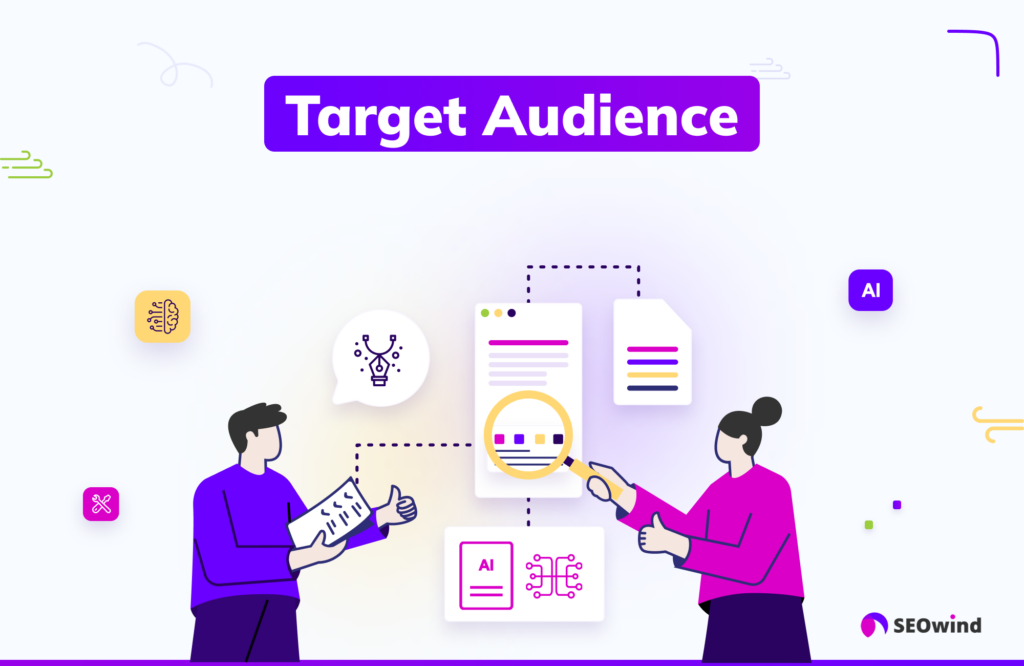
Understanding your target audience is the foundation of crafting a successful SEO content strategy. Knowing who you are trying to reach is crucial, as it will inform every decision after this step. There are three main aspects you need to cover when discovering your target audience:
Demographics
Start by gathering demographic data such as age range, gender, geographical location, and other common attributes. This information will help you create a detailed profile of the individuals most likely to engage with your brand or business.
Psychographics
In addition to demographics, research your target audience’s interests, values, attitudes, and behaviors. This will facilitate a deeper understanding of their motivations and preferences, allowing you to craft content that resonates with them emotionally.
Pain Points & Needs
Identify the challenges and needs confronted by your target audience in their daily lives or while searching for solutions related to your industry. By addressing these pain points through high-quality content, you can position yourself as an authoritative source of information.
To gather this information:
- Conduct surveys among existing customers or followers
- Use social media listening tools
- Study competitors’ audiences and make a note of trends
Once you comprehensively understand your target market’s characteristics and needs, tailor each aspect of your SEO content strategy around effectively reaching and engaging with them. Doing so will improve search rankings and cultivate genuine connections between your brand and its ideal consumers.
Step 2: Conduct Keyword Research and Develop a Topic List

Developing an SEO content strategy requires thorough keyword research and a comprehensive topic list. This process enables you to create targeted, high-quality content that resonates with your audience and ranks well in search engines.
Find topics with search traffic potential
Keyword research is essential for identifying topics with search traffic potential. The goal is to uncover particular keywords or phrases people actively use while searching your industry or niche online.
To accomplish this:
- Use keyword research tools like Google Keyword Planner, Ahrefs, or SEMrush to discover popular search terms for your business.
- Examine competitors’ websites and observe which keywords they target through their content.
- Explore relevant forums, Q&A websites, and social media platforms to identify trending discussions and frequent inquiries surrounding your field.
Remember to prioritize long-tail keywords as they tend to have lower competition levels and higher conversion rates, maximizing the efficiency of your SEO efforts.
Check their business value
Before diving into content creation, assessing the business value of identified topics is crucial by considering factors such as relevance, competitiveness, and buyer intent.
- Relevance: Ensure the topic aligns with your brand identity and addresses the concerns or interests of your target audience.
- Competitiveness: Analyze the top-ranking pages for each chosen keyword to determine if there is an opportunity for improvement or innovation.
- Buyer Intent: Identify where each keyword falls within the buyer’s journey (awareness stage, consideration stage, decision stage) so that you can create valuable content tailored specifically to each stage.
Selecting topics with significant business value ensures efficient resource allocation of time and effort when developing your SEO content plan.
Analyze ranking potential
Evaluating ranking potential is vital in defining a successful SEO content strategy. Ranking potential refers to the likelihood of your content ranking highly in search engine results pages (SERPs) for specific keywords. Assessing ranking potential involves:
- Analyzing the strength of your website’s domain authority and comparing it with competitors’ sites targeting similar keywords.
- Studying the factors contributing to high-ranking competitor content, such as page title optimization, keyword usage, link-building strategies, and overall user engagement.
Considering these aspects, you make informed decisions on which topics warrant investment and contribute significantly to achieving optimum reach through a well-executed SEO content strategy.
Step 3: Create High-Quality, Search-Focused Content
Ensuring the production of high-quality, search-focused content is crucial when crafting an effective SEO strategy. This type of content appeals to your target audience and meets search engines’ requirements and expectations. Here’s how you can create value-driven content that boosts your visibility on search results:
Understand User Intent
One of the first steps in creating relevant and engaging content is understanding the intent behind your users’ queries. Study what your target audience looks for when they use specific keywords or phrases. Doing so will enable you to effectively create content that addresses their needs and concerns. Incorporating user intent into your SEO content strategy aligns your site with the searcher’s goals and search engine algorithms.
Write Exceptional Content
Quality should be a top priority throughout your SEO journey – especially when creating content. Producing compelling articles, blog posts, videos, and multimedia elements can set you apart from competitors:
- Be informative: Provide accurate information based on facts and cite reliable sources.
- Avoid plagiarism: Produce original material instead of copying others’ work.
- Use proper grammar: Correct spelling, punctuation, capitalization, and sentence structure.
Additionally, consider hiring experienced writers or editors to uphold these standards.
Utilize Long-Tail Keywords
Long-tail keywords (phrases containing 3+ words) usually compete less than short-tail ones (1-2 words). Incorporating them into your SEO content strategy improves the chances of ranking highly on SERPs (Search Engine Results Pages) and reaching the most relevant audience segments. While long-tail keywords often receive less total traffic than their shorter counterparts, they tend to bring more targeted visitors interested in what you offer.
Optimize For Readability
While optimizing your website for search engines is crucial, remember to cater to human readers. Ensure your content is easily digestible and visually appealing by:
- Using clear, concise language
- Dividing articles into smaller sections with appropriate headings and subheadings
- Including bullet-point lists or numbered summaries when applicable
- Breaking up long paragraphs into shorter ones
Taking these measures will result in a user-friendly experience that keeps visitors engaged.
Include Visuals Impactfully
Visuals play an essential role in increasing the appeal of your content, capturing attention, and improving comprehension. Incorporating different types of multimedia within your SEO content strategy, such as images, videos, infographics, or graphs, can significantly enhance your site’s overall presentation. When you use visual elements effectively, they provide added value for both users and search engines alike.
Step 4: Create a content calendar
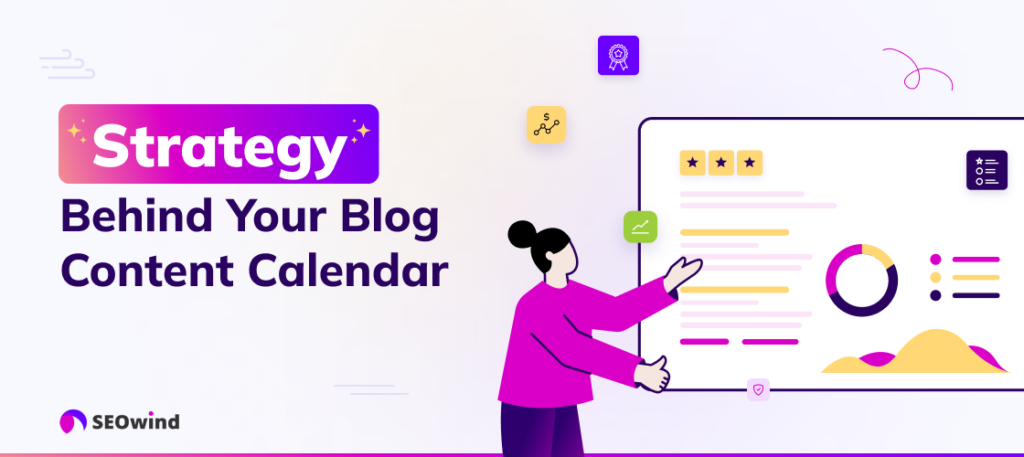
A well-planned content calendar is crucial for the success of any SEO content strategy. It helps you stay organized, maintain consistency, and manage your publishing schedule effectively. This section will discuss the benefits of having a content calendar and provide some tips to create one that works for you.
Benefits of having a content calendar
- Consistency: Regularly publishing high-quality content is vital in maintaining your site’s visibility on search engines. A content calendar ensures that your output remains consistent over time.
- Organization: Develop an overview of the topics you’ll cover over several months. This lets you plan, keep track of ideas and deadlines, and ensure every piece aligns with your overall SEO content strategy.
- Collaboration: A shared content calendar encourages collaboration within your team or between contributors, as it makes everyone aware of ongoing projects and upcoming deadlines.
- Efficiency: A well-planned calendar allows you to streamline internal processes like assigning tasks, reviewing drafts, identifying gaps in coverage, and ensuring no resources are wasted on repeating similar topics.
Tips for creating an effective content calendar
- Choose the right platform: Depending on your needs and preferences, some popular options for maintaining a digital calendar are Google Calendar, Trello, Asana, or Microsoft Excel.
- Create categories or tags: Grouping similar topics can help you generate new ideas by exploring related subtopics while enhancing discoverability when reviewing published posts.
- Prioritize important dates: Outline key industry events or seasonal trends relevant to your audience; this can inform timely blog posts or social media campaigns tailored around such occasions.
- Balance evergreen and trending topics: While taking advantage of time-sensitive opportunities to capitalize on current events or discussions in the field–you also create high-quality evergreen content that stays relevant and maintains your site’s visibility in the long run.
- Plan for flexibility: Unexpected events may arise that warrant adjustments in your publishing schedule. Build some buffer time into your calendar to accommodate such last-minute shifts without compromising deadlines or consistency.
By successfully implementing a content calendar, you will transform your SEO content strategy into an organized process that drives results. Schedule each post with thoughtfulness and intention, leveraging keyword research and varied content formats to engage readers while maximizing reach across search engines. Ultimately, achieving consistent growth depends on maintaining a solid foundation through effective planning and execution of a strategic content calendar.
Step 5: Incorporate Various Content Formats
To truly maximize your reach and increase user engagement, it’s crucial to integrate a variety of content formats into your SEO content strategy. Diversifying your content allows you to cater to different audience preferences and keep readers interested in what you say long-term. Here are some popular content formats that can boost your SEO efforts:
- Blog Posts: Blog posts are the backbone of most online content strategies. They provide an excellent opportunity for keyword utilization, thought leadership, and information sharing.
- Videos: Video consumption is ever-growing, so incorporating video into your content plan can significantly enhance user experience and appeal to those who prefer visual storytelling.
- Infographics: Infographics present complex data or concepts in a visually appealing and easy-to-understand manner. This format encourages social sharing, leading to increased visibility and backlinks.
- Podcasts: Audio-based podcast episodes allow you to reach audiences searching for knowledge on the go or while multitasking.
- E-books: Long-form e-books demonstrate expertise in-depth on a particular topic, which may attract niche target markets interested in comprehensive resources.
- Listicles: Lists with concise tips or information points promote the ease of reading because users perceive them as digestible chunks of advice they can apply quickly.
Remember, adding multimedia elements like images, graphs, and interactive widgets within textual content can also support overall readability and make the material more engaging. Implementing different types of native media (or even blending multiple formats) when creating website assets tailored towards specific buyer personas or customer journey stages helps ensure broader success for your SEO initiatives over time.
Various factors must be considered when deciding which type(s) might suit specific business purposes well. For example, audience demographic preferences alongside their preferred channels/platforms/devices should drive most decisions about engaging potential customers/users through diverse touchpoints aligned around overlapping objectives.
Step 6: Fully Optimize Content

Once you have created high-quality content that engages your target audience, it’s crucial to fully optimize it as part of a comprehensive SEO content strategy. Proper optimization ensures your articles perform well in search engines and provide maximum value to readers.
There are several factors to consider when optimizing content for SEO:
Keyword Placement
Place your primary keyword and other relevant keywords naturally throughout the article. Aim for a keyword density between 1% and 2%, which is considered optimal by most SEO experts. When possible, incorporate these strategically placed phrases into headings, subheadings, body text, image alt tags, meta descriptions, and URL structures.
Readability
Ensure your content is easily digestible by maintaining short paragraphs, diverse sentence lengths, bullet points/lists where appropriate, and using a conversational tone. Balancing readability and keyword usage helps create better user engagement and positively affects search engine rankings.
Meta Data Optimization
Optimizing on-page elements such as title tags, meta descriptions, header tags (H1-H6), and structured data is essential. Well-written titles should include the target keyword near the beginning while remaining engaging enough for users to click through. Meta descriptions need to summarize what the page is about enticingly, as they frequently appear in search engine results pages (SERPs).
Internal and External Linking
Incorporate internal links to other relevant sections of your website and external links to authoritative sources within your industry. Providing valuable resources for additional information can increase dwell time on your site—a positive ranking signal according to Google and further build trust with your audience.
Multimedia Usage
Include various media types like images, videos, infographics, or GIFs in your content. Not only does this make your writing visually appealing, but it also contributes exponentially towards click-through rates (CTR) from SERPs. Ensure images have descriptive alt attributes and filenames that contain targeted keywords.
Step 7: Schedule Posts Often
Consistency is vital when it comes to implementing your SEO content strategy. Scheduling regular posts is an effective tactic to maintain the interest of your audience, keep search engines crawling and indexing your website, and ultimately enhance your online presence.
The Importance of Regular Content Posting
Publishing fresh content frequently has various benefits:
- Audience Engagement: Ensuring a steady flow of new content gives readers a reason to revisit your website and keeps them engaged with your brand.
- Search Engine Indexation: Search engines, such as Google, prioritize websites that consistently update their content because it demonstrates expertise, authoritativeness, and trustworthiness.
- Keyword Ranking: Frequent posting provides more opportunities to rank for various keywords related to your industry or niche.
- Increased Website Traffic: As you publish more relevant content consistently, the likelihood of attracting organic traffic from search engine results pages (SERPs) rises.
Developing a Posting Schedule
To create a successful posting schedule as part of your SEO content strategy, consider these steps:
- Determine post frequency: Establish how many times per week or month you can consistently provide high-quality content without compromise. This could be daily, weekly, or bi-weekly; maintaining consistency matters most.
- Create a content calendar: Organize upcoming topics in a calendar format to help streamline the planning process and ensure everything stays on track (aligning with Steps 4 and 5 mentioned earlier).
- Use scheduling tools: Utilize online tools like HootSuite or Buffer for social media sharing of published articles to manage multiple platforms’ posting schedules efficiently.
- Analyze performance: Track analytics data regularly through platforms such as Google Analytics or SEMrush to understand which pieces resonate most with readers and optimize future strategies accordingly.
By focusing on scheduling regular posts within the framework of your SEO content strategy, you’re more likely to sustain your website’s growth and improve its search rankings over time. Remember that quality always surpasses quantity, and keeping a manageable posting schedule will prevent content burnout while ensuring your audience stays engaged.
Step 8: Develop a Link Building Strategy
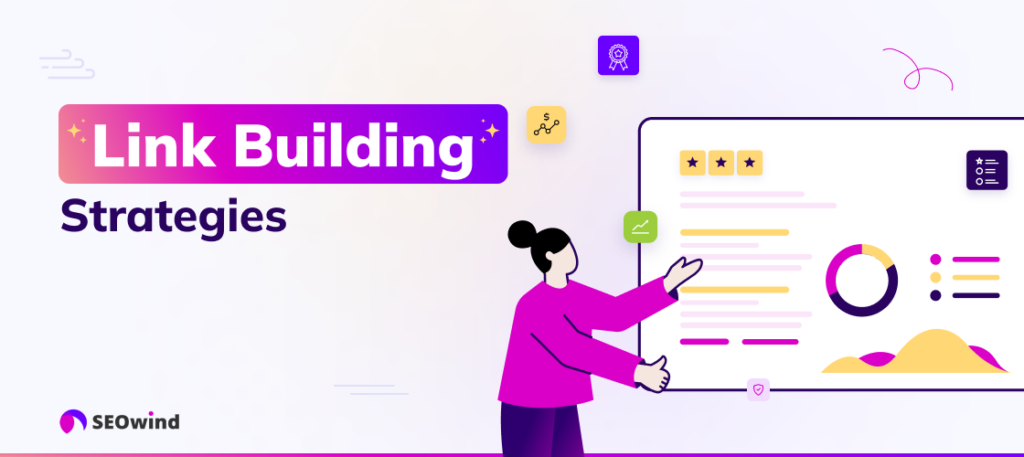
A robust link-building strategy is critical to an effective SEO content strategy. High-quality backlinks from reputable websites can significantly boost your search engine rankings, increase referral traffic, and solidify your brand’s authority in your industry. In this section, I will discuss the importance of developing a comprehensive link-building strategy and provide tactics to help you secure valuable backlinks.
Importance of Link Building
Link building plays a key role in enhancing the visibility and credibility of your website:
- Higher search engine rankings: High-quality backlinks signal that your content is valuable and relevant to search engines. Thus, they contribute positively to your site’s overall domain authority.
- Referral traffic: Backlinks from popular websites can drive more visitors to your site, increasing potential leads or sales.
- Building relationships: Connecting with other reputable websites for link exchanges can foster strategic partnerships that benefit both parties.
Tactics for Effective Link Building
- Create share-worthy content: Producing high-quality, informative content makes it more likely that others will naturally link to your material or share it on social platforms. Don’t forget various formats like infographics or videos, which could be highly shareable!
- Guest blogging: Contribute guest posts for authoritative blogs within your niche. This exposes you to a broader audience and provides opportunities for obtaining quality backlinks.
- Outreach: Identify influencers and industry-related websites that may find value in linking with your content based on their target audience. Reach out via email or direct message with a personalized note explaining how linking to your piece augments your article.
- Analyze competitors’ links: Use tools like Ahrefs or Moz’s Open Site Explorer to study the sites giving backlinks to your competitors. It’ll offer insights into which sites may be amenable to providing links related to your niche.
- Broken link building: Locate websites with broken external links and offer them high-quality content from your site as replacements for non-functioning links.
- Resource pages: Identify resource pages or directories within your industry where you can suggest adding a link to one of your articles or guides.
By following these tactics, you’ll begin cultivating healthy backlinks that drive ongoing, organic traffic to your website. Remember that link-building takes persistence and patience! Don’t expect immediate results but stay consistent in developing long-lasting relationships and strengthening your SEO content strategy.
Step 9: Continually Update User Experience and Content

An effective SEO content strategy is not a one-time effort. It requires continuous evaluation, refinement, and adaptation to stay relevant and maintain its benefits. This step will discuss the importance of regularly updating user experience (UX) and content. Additionally, we shall explore some best practices that can help you achieve optimal results.
Importance of Updating User Experience
User experience is critical to driving organic traffic and retaining your audience. A user-friendly website boosts engagement levels and sends positive signals to search engines like Google, which prioritize viewer satisfaction.
There are several considerations for enhancing the user experience on your webpage:
- Site speed: Ensure your site loads quickly on desktop and mobile platforms since slow-loading webpages lead to higher bounce rates.
- Mobile-friendliness: Make sure your site is easy to navigate and use on mobile devices as more users are shifting towards this medium.
- Clear call-to-action (CTA): Include engaging CTAs that prompt users to interact with your site further—helping improve conversion rates.
- Straightforward navigation: Create an intuitive sitemap to direct viewers effortlessly through different parts of your website.
Regularly review your UX to identify areas of improvement in performance or design optimization.
Keeping Your Content Fresh
Up-to-date content contributes significantly to the success of your SEO content strategy because it holds relevance based on present trends or evolving information within an industry domain.
Here are some benefits of periodically refreshing your content:
- Enhances overall quality by addressing gaps or outdated information
- Boosts credibility due to authoritative resourcefulness
- Increases engagement by offering new perspectives or value-added insights
- Elevates ranking potential because search algorithms reward fresh content
To keep track of updates, consider implementing these practices:
- Content audit: Perform audits using tools like Google Analytics to detect underperforming content, then strategize and revamp as necessary.
- Evergreen topics: Write on timeless subjects that will remain relevant, ensuring a constant flow of organic traffic.
- Content repurposing: Reformat existing material into new forms like infographics or podcasts to tap into alternative channels for discovering your content.
Remember that an effective SEO content strategy involves fostering positive user experience by implementing website enhancements and consistently renewing your content—which goes hand-in-hand with maintaining engagement levels and improving search engine rankings over time.
Step 10: Analyze your content performance
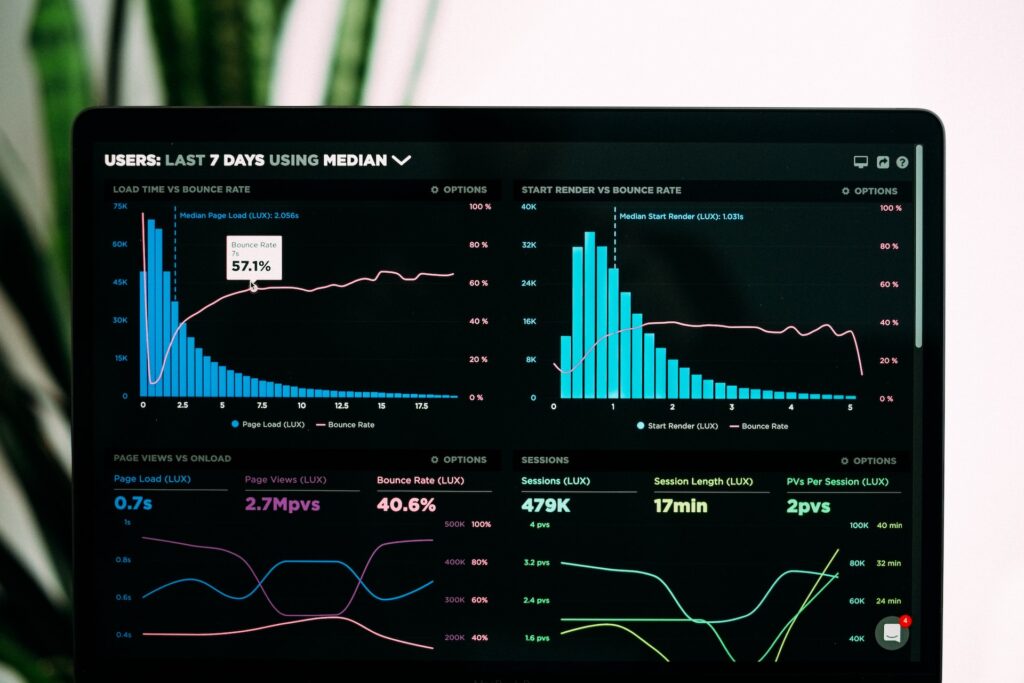
After implementing your SEO content strategy, it is crucial to assess the performance of your content frequently. The continuous analysis will enable you to identify which aspects of your strategy are working effectively and make informed decisions about what needs improvements. To properly analyze your content performance, consider employing these approaches:
Set Clear Goals and Key Performance Indicators (KPIs)
First and foremost, establish clear objectives for your SEO content strategy. Determine what success looks like for your business – increased search engine rankings, higher organic traffic, or improved conversion rates. Next, define specific KPIs to help measure your progress toward these goals. Examples include total organic sessions, bounce rate, average session duration, number of backlinks acquired, and user engagement.
Implement Tracking Tools
Adopt various analytic tools such as Google Analytics and Search Console to monitor the data related to your website’s performance. These tracking instruments provide valuable insights into the effectiveness of your SEO efforts and identify areas that need improvement.
Monitor Keyword Rankings
Keeping a close eye on the rankings for targeted keywords will help you gauge how well-optimized individual pieces of content are performing in search engine results pages (SERPs). Track short-term fluctuations and long-term trends in keyword rankings to determine if adjustments to on-page optimization or off-page link-building efforts may be necessary.
Assess User Engagement Metrics
To understand how users interact with your website, study vital user engagement metrics such as pages per session, average time spent on the page/site, and social media shares or comments. High user engagement indicates relevance between content quality/functionality features, e.g., loading time) and visitor expectations; low levels signal dissatisfaction, warranting further refinements.
Evaluate Conversion Rates
An effective SEO content strategy should ultimately increase conversions – whether newsletter signups, product purchases, or other desired outcomes. Weave conversion rate optimization techniques into each piece of content and monitor conversion performance to determine the success of your overall SEO content marketing strategy.
By regularly analyzing your content performance, you’ll better understand what resonates with your target audience and search engines. This knowledge can be leveraged to refine your SEO strategy continuously, ensuring steady growth in organic traffic, higher search engine rankings, and improved conversions for your business.
How to Create SEO Content
Find a Target Keyword to Center Content Around
Selecting a target keyword is the first step in creating an effective SEO content strategy. Your chosen keyword should closely align with the central topic of your piece and reflect what users are searching for. Identifying and utilizing relevant keywords allows you to create content that better addresses search queries, improving site visibility and driving targeted traffic. Tools such as Google Keyword Planner, SEMrush, or Ahrefs can help research popular terms related to your niche.
Be Original
In a sea of online content, originality reigns supreme. Strive to bring unique insights and fresh perspectives to your audience, setting yourself apart from competitors within your industry. Duplicate content disinterests readers and harms your overall SEO content marketing strategy by harming search engine ranking potential. When producing new material, focus on developing engaging pieces that offer value beyond what’s available elsewhere.
Place Your Chosen Keyword Prominently
Once you’ve selected a target keyword, it’s essential to incorporate it prominently within your content while keeping language natural and unforced. To maximize effectiveness and avoid penalties from search engines due to keyword stuffing:
- Place the primary keyword in the title tag of the page.
- Include the main keyword within meta descriptions.
- Use headers (e.g., H1/H2) that contain the target keyword.
- Ensure keywords appear naturally throughout an article without excessive repetition.
Maintaining these practices will ensure proper targeting while bolstering seamless ease-of-read for visitors.
Provide Long-Form, Comprehensive Content
Research has shown that long-form articles rank higher than shorter ones when offering comprehensive information on a particular subject matter— typically around 1500 – 2000 words per article. Consequently, well-researched data exploration fosters increased user satisfaction while allowing greater keyword inclusion opportunities.
In crafting detailed material:
- Thoroughly research your topic to understand all angles.
- Address both pros and cons, resolving user queries with a comprehensive perspective.
- Supplement information with cited sources, enhancing credibility^.
Long-form content demonstrates expertise in your field and improves the chances of attaining backlinks from other websites, strengthening your off-page SEO strategy.
Make Your Content Attractive to Readers
Well-organized and visually appealing content captures readers’ attention while facilitating breezier navigation. To optimize user engagement:
- Employ short paragraphs with clear spacing, aiding readability.
- Incorporate bullet points or numbered lists for a concise presentation.
- Break article sections using relevant header tags (H1/H2).
- Ensure text styles and fonts are consistent throughout, presenting polished visuals for on-site display.
Leveraging these devices boosts page aesthetics alongside audience comprehension and interaction levels.
Incorporate Different Types of Multimedia
Incorporating multimedia elements diversifies content offerings while engrossing users through varied modes of interaction. Consider bolstering written material with the following:
- Images: Use high-resolution graphics that effectively complement text; avoid excessive file sizes, which slow down loading times.
- Videos: Integrate educational or explanatory videos demonstrating concepts or providing additional insights into an article.
- Infographics: Utilize visual representations to convey complex data points and facts quickly.
By engaging visitors on multiple sensory fronts, curating diverse multimedia assets enhances overall material quality, contributing to your holistic SEO content strategy success.
What are some great examples of SEO content strategy?

Throughout the digital marketing world, several businesses have implemented highly successful SEO content strategies that we can learn from and emulate. Analyzing these real-world examples will enable us to understand the concepts, practices better, and approaches detailed in this article. Here are a few such instances to inspire your content strategy.
HubSpot: All-inclusive resource center
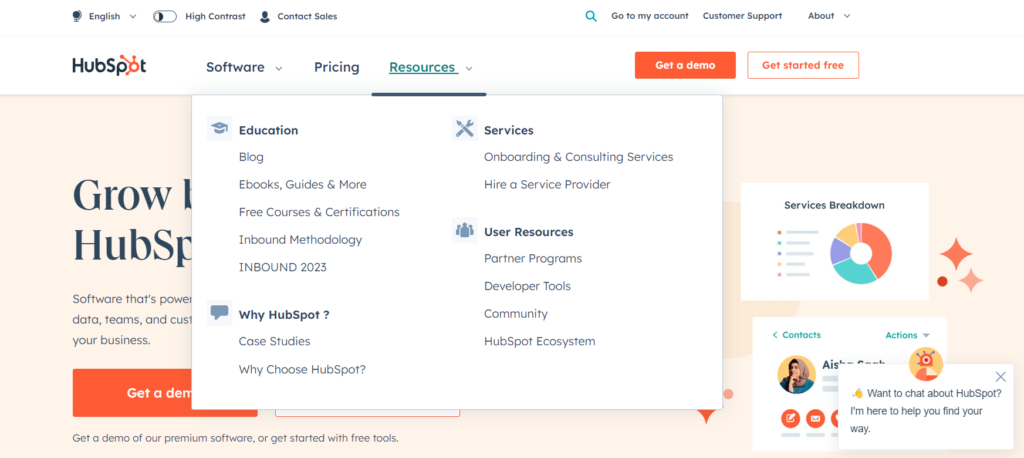
HubSpot is well-known for its comprehensive approach to inbound marketing. Their all-encompassing resource center includes blog posts, eBooks, free tools, webinars, and much other high-quality content focused on helping clients improve their marketing efforts. This is an excellent example of how an organized and diverse content marketing SEO strategy can boost website traffic by addressing various pain points within their target audience.
To further its reach, HubSpot utilizes on-page content strategy techniques, such as incorporating keywords throughout the webpage’s text while crafting compelling meta descriptions to increase search engine rankings.
Moz: Expertise-driven guides
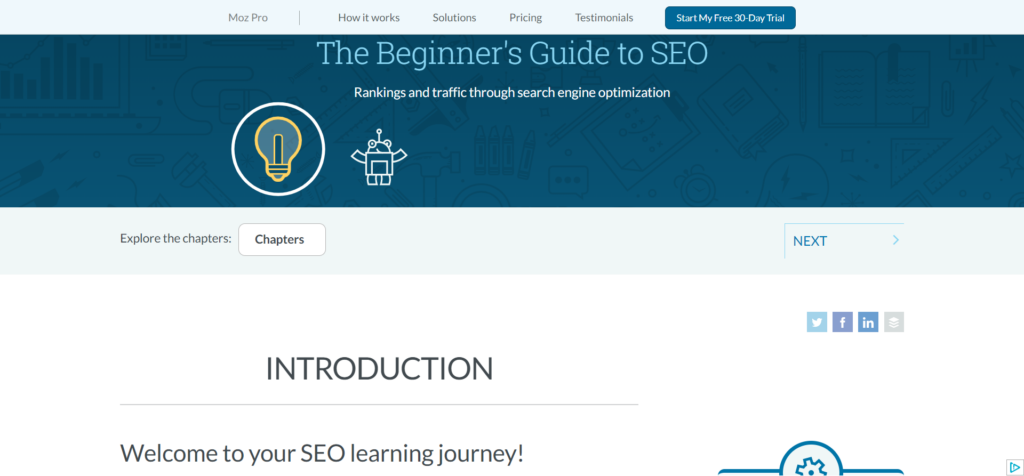
Moz excels at providing value through expertise. As a leading authority on SEO, they maintain a popular blog covering topics related to SEO best practices, industry updates, and more technical aspects like link building or algorithm changes. They also provide “The Beginner’s Guide to SEO,” which sets a gold standard in long-form educative material serving beginners and seasoned marketers alike.
Using an SEO content strategist, Moz focuses on producing informative articles that address common challenges users face while staying updated with industry-related news and trends – thereby establishing itself as a go-to source for top-tier insights into everything related to search engine optimization.
Airbnb: Storytelling combined with local expertise
Airbnb has created outstanding locality-based travel guides with valuable insights from data collected in different parts of the world. These stories allow them to connect emotionally with potential customers while showcasing unique experiences that solidify their brand’s position as an expert in providing authentic travel experiences.
In this what is SEO content strategy example, Airbnb emphasizes local keywords and user-generated content derived directly from their users’ experiences – all while maintaining a compelling narrative that keeps readers interested and engaged.
Nike: Focused product-driven content
Industry giant Nike has always excelled at remaining relevant through consistent yet captivating product-centered storytelling. Incorporating various types of multimedia (video, image, audio), they develop highly optimized content centered around delivering engaging consumer experiences while promoting the products.
Using both an on-page content strategy to increase search engine rankings and employing influencers or partners across different channels, Nike consistently revitalizes its marketing approach to stay ahead of the curve while staying true to their core brand values.
These examples demonstrate how versatile and powerful a well-executed SEO content strategy can drive online success. Whether it involves creating comprehensive resources or crafting emotionally resonant narratives, top-tier organizations understand that combining high-quality content with intelligent optimization techniques is vital for thriving in today’s competitive digital landscape.
How is an Audience-Focused Content Strategy Different from a Keyword-Focused Content Strategy?
When developing an SEO content strategy, it’s essential to understand the difference between audience-focused and keyword-focused approaches. While both strategies aim to improve your online presence and search engine rankings, they differ in methodology and primary objectives.
Audience-Focused Approach
An audience-focused content strategy strongly emphasizes understanding your target audience and creating content that appeals directly to them. This approach considers the following factors:
- Audience segment: Identifying specific subsets of your target audience based on demographics, interests, or pain points.
- User Intent: Gaining insight into what your users seek when searching for your brand or industry information.
- Content relevance: Ensuring that your content satisfies the needs and expectations of your target audience by addressing their concerns or answering their questions.
In this approach, while keywords still play a role in optimizing content for search engines, the primary focus lies in engaging readers through relevant and valuable material. Connecting with your audience fosters trust and loyalty, ultimately contributing to long-term brand growth.
Keyword-Focused Approach
A keyword-focused content strategy involves selecting and centering content around high-potential keywords. The main objectives of this strategy include:
- Keyword research: Extensive research on popular searches in your niche to discover untapped opportunities that have the potential to drive traffic.
- Competitor analysis: Evaluating top-performing competitor content targeting similar keywords so you can create even better material.
- On-page optimization: Implementing best practices like strategically targeting keywords throughout titles, headings, meta tags, URL structure, anchor texts, and image alt attributes.
With a keyword-driven approach, you primarily optimize web pages for search engines rather than solely focusing on connecting with human readers. Although short-term gains may be achievable through improved ranking positions on SERPs (Search Engine Results Pages), this method lacks the depth of connection that an audience-focused approach can provide.
Striking a Balance
Finding the right balance between an audience-focused and keyword-focused content strategy is crucial. Focusing solely on keywords may result in dry, robotic content that doesn’t resonate with your readers while ignoring search engine optimization renders your excellent material invisible to potential users.
To develop a winning SEO content strategy:
- Start by identifying your target audience and understanding their needs.
- Conduct comprehensive keyword research, keeping user intent in mind.
- Create high-quality content addressing topics important to your audience while incorporating strategic keywords for optimal search engine optimization.
- Constantly analyze user behavior, engagement metrics, and content performance data to make informed decisions about future content creation and outreach initiatives.
By considering audience and keywords in tandem, you can create impactful SEO content marketing strategies that increase traffic, higher engagement rates, and better online brand visibility.


